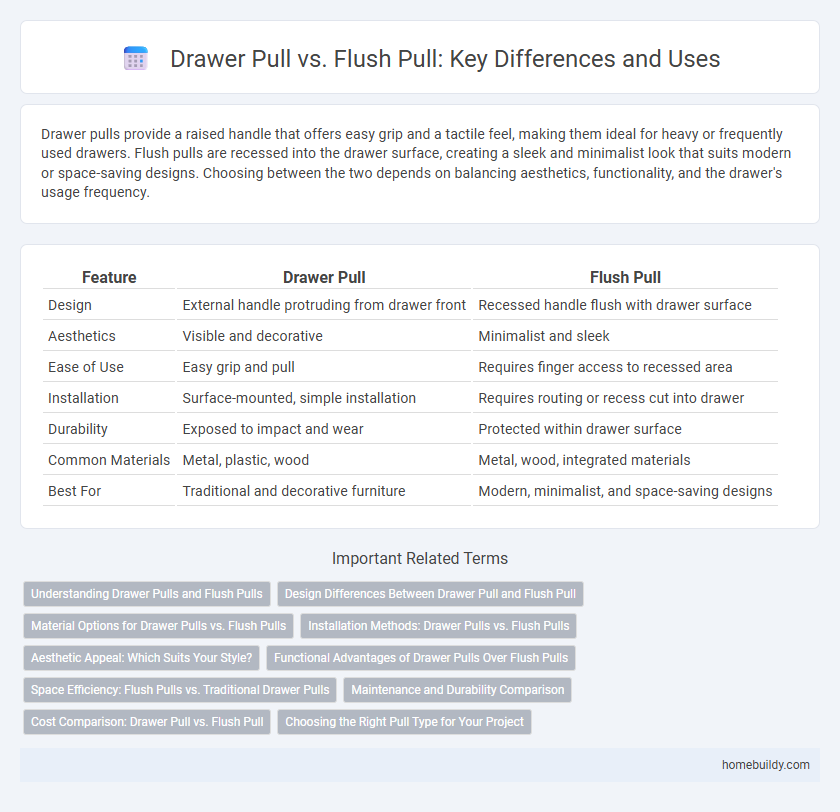Drawer pulls provide a raised handle that offers easy grip and a tactile feel, making them ideal for heavy or frequently used drawers. Flush pulls are recessed into the drawer surface, creating a sleek and minimalist look that suits modern or space-saving designs. Choosing between the two depends on balancing aesthetics, functionality, and the drawer's usage frequency.
Table of Comparison
| Feature | Drawer Pull | Flush Pull |
|---|---|---|
| Design | External handle protruding from drawer front | Recessed handle flush with drawer surface |
| Aesthetics | Visible and decorative | Minimalist and sleek |
| Ease of Use | Easy grip and pull | Requires finger access to recessed area |
| Installation | Surface-mounted, simple installation | Requires routing or recess cut into drawer |
| Durability | Exposed to impact and wear | Protected within drawer surface |
| Common Materials | Metal, plastic, wood | Metal, wood, integrated materials |
| Best For | Traditional and decorative furniture | Modern, minimalist, and space-saving designs |
Understanding Drawer Pulls and Flush Pulls
Drawer pulls typically protrude from the drawer front, offering a tactile grip that facilitates easy opening, while flush pulls are recessed into the surface, providing a streamlined and minimalist appearance ideal for modern cabinetry. The choice between drawer pulls and flush pulls often depends on aesthetic preference, functionality, and space constraints, with flush pulls being favored in tight areas where protruding hardware may catch on clothing or hinder movement. Material options for both types range from brass and stainless steel to plastic, impacting durability and design compatibility.
Design Differences Between Drawer Pull and Flush Pull
Drawer pulls protrude from the drawer front, offering a tactile grip and decorative element, often crafted from metals like brass or stainless steel with varied shapes and finishes. Flush pulls are recessed into the drawer surface, creating a sleek, minimalist design ideal for modern or space-saving furniture, typically made from materials such as aluminum or plastic. The primary design difference lies in their installation depth and visual impact, where drawer pulls emphasize outward accessibility and flush pulls focus on streamlined aesthetics.
Material Options for Drawer Pulls vs. Flush Pulls
Drawer pulls offer a wider variety of material options, including metals like brass, stainless steel, and zinc alloy, as well as wood and plastic, providing versatile aesthetic and durability choices. Flush pulls are commonly made from metals such as stainless steel or aluminum to maintain a sleek, recessed profile, which limits material variety but enhances minimalist design. Choosing between these pulls depends on the desired balance between material diversity and the functional, streamlined look of the drawer hardware.
Installation Methods: Drawer Pulls vs. Flush Pulls
Drawer pulls typically require surface mounting, involving screws or bolts inserted through the drawer front for straightforward installation. Flush pulls are recessed into the drawer surface, necessitating precise mortising or routing to create a cavity, making installation more complex and time-consuming. Choosing between these depends on the desired aesthetic and skill level for accurate alignment during installation.
Aesthetic Appeal: Which Suits Your Style?
Drawer pulls offer a prominent and decorative aesthetic, often enhancing traditional and rustic styles with their raised design and varied finishes. Flush pulls provide a sleek, minimalist look by sitting flush with the drawer surface, ideal for modern and contemporary interiors seeking clean lines. Choosing between drawer pulls and flush pulls depends on whether you prefer a bold, tactile element or a subtle, integrated appearance for your cabinetry.
Functional Advantages of Drawer Pulls Over Flush Pulls
Drawer pulls offer superior grip and ease of use compared to flush pulls, making them ideal for frequent access and heavier drawers. Their raised design allows for quick opening without requiring precise finger placement, enhancing accessibility for users with limited dexterity. Furthermore, drawer pulls provide a tactile feedback that minimizes slippage, contributing to safer and more efficient drawer operation.
Space Efficiency: Flush Pulls vs. Traditional Drawer Pulls
Flush pulls optimize space by sitting flush within the drawer surface, eliminating protrusions and allowing drawers to open smoothly in tight spaces. Traditional drawer pulls extend outward, which can limit space efficiency and cause obstruction in compact areas. Choosing flush pulls enhances functionality in small kitchens, closets, or furniture requiring a sleek, unobtrusive profile.
Maintenance and Durability Comparison
Drawer pulls typically require regular cleaning and occasional tightening to maintain their functionality, whereas flush pulls, being recessed, accumulate less dust and are less prone to loosening over time. The durability of drawer pulls often depends on the material used, with metal variations offering higher resistance to wear and tear compared to plastic counterparts. Flush pulls, due to their integrated design, generally experience less physical impact, resulting in longer-lasting performance and reduced maintenance needs.
Cost Comparison: Drawer Pull vs. Flush Pull
Drawer pulls typically cost between $5 and $20 per piece, offering a wide range of affordable options suitable for various budgets. Flush pulls, designed to sit recessed within the drawer surface, generally have a higher price range, often from $10 to $30, due to their more complex installation and sleek design. Cost considerations should factor in installation complexity and material quality, with flush pulls requiring precise fitting that may increase labor expenses compared to the simpler installation of drawer pulls.
Choosing the Right Pull Type for Your Project
Drawer pulls provide a traditional grip style that is easy to grasp and ideal for high-use cabinetry, while flush pulls offer a sleek, minimalist design that is perfect for modern, space-saving applications. Choosing the right pull type depends on factors such as the overall aesthetic of your project, the frequency of use, and ergonomic preferences. Consider the functionality and design compatibility of drawer pulls versus flush pulls to enhance both the usability and style of your cabinetry.
Drawer pull vs Flush pull Infographic

 homebuildy.com
homebuildy.com